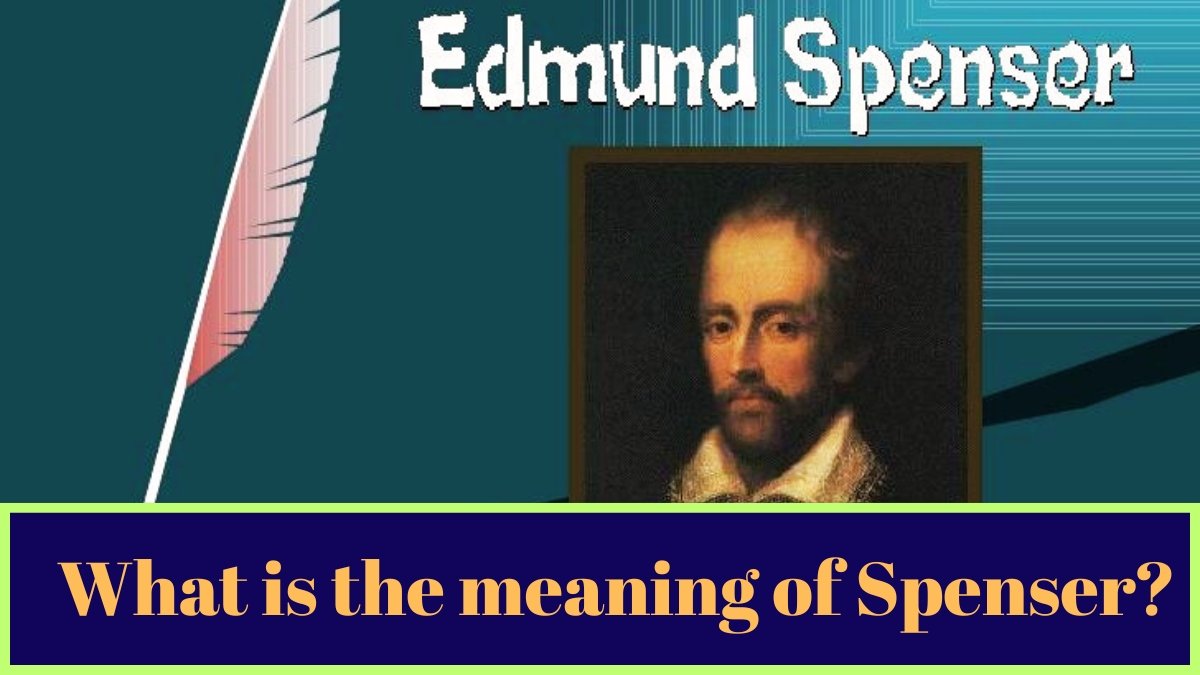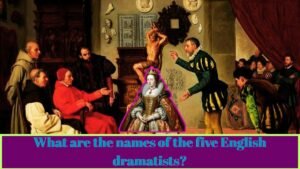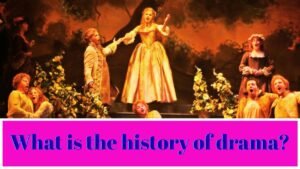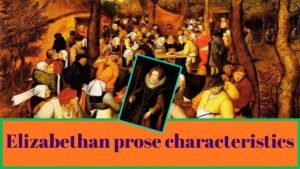What is the meaning of Spenser?

The Shepherd’s Calendar-Spenser: his life and works-The Fairy Queen in detail.Tottell‘s Miscellany appeared in 1557 and summed up in the work of Wyatt and Surrey the poetic achievement of early English Renais-sance. Nothing of real merit appeared during the next two decades, for though there are some good things in Sackville and Gascoigue, they did not make any significant contribution. Then a new star suddenly blazed on the literary firmament. This was Edward Spenser. With him we are in the full tide of the Renaissance in England. The appearance of his Shepherd’s Calendar in 1579 opened a new epoch in English poetry. Nothing like this had been written after Chaucer, and Spenser was universally acclaimed as the topmost poet of the age. His position as the second great poet of England was confirmed by the publication, eleven years later, of the Fairy Queen,his master-piece.
Spenser who belonged to a poor Lancashire family was born in London about 1552. He was educated at Cambridge where he took his M.A. degree in 1576. He was admitted to the household of the Earl of Leicester and thus to the friendship of Sir Philip Sidney, his nephew. In 1580 he went to Ireland as secretary to the governor and lived there an exile for the rest of his life except for two short visits to England. He held various government offices in Ireland and ultimately settled there on a large estate granted to him. There he was visited by Sir Walter Raleigh to whom he read his Fairy Queen. Sir Walter was so delighted with the poem that he brought him over to England and introduced him to the Queen who conferred upon him a pension of £50 a year. It was during this visit (1589-90) that the Fairy Queen containing the first three books was published (1590). On his second visit to England (1595-96) he brought with him the other three books of the Fairy Queen (together with a fragment on Mutability for the seventh book) and these were published in 1596. Failing to obtain any further court favour he returned to Ireland. In a rebellion in 1598 his castle was burnt down and he escaped to England. He died in extreme poverty at an inn in London in January 1599. He was buried near Chaucer in the Poet’s Corner in West-minster Abbey.
Why is Spenser called the poet of poets?
Works. Besides The Shepherd’s Calendar and The Fairy Queen, Spenser’s most important works are: Astrophel, a pastoral elegy on the death of Sir Philip Sidney, Colin Clout’s Come Home Again, Amoretti, a sonnet cycle and Epithalamion, a marriage Ode, both addressed to his wife; Prothalamion, celebrating the marriage of the two daughters of the Earl of Worcester; and Four Hymns in Honour of Love and Beauty.
Among his minor works may be mentioned the Complaints con-taining sundry small poems of the world’s vanity. Two of these, Mother Hubert’s Tale and Tears of the Muses, are of interest as showing Spenser’s pessimism induced, no doubt, by personal frus-tration. His disappointment in getting court favour found expression in Mother Hubert’s Tale, a satire on the court, the clergy and Lord Burleigh, the close-fisted Chancellor of the Queen. Tears of the Muses bewails the sad state of the Muses who have no patrons in this barbaric age.
The Shepherd’s Calendar with which Spenser made his poetic debut is a pastoral poem modelled on Theocritus and Virgil and their Italian and French followers of the Renaissance. It consists of twelve eclogues or short pastoral poems, one for each month of the year. They are in the form of dialogues among shepherds including the poet under the name of Colin Clout. Though the Calendar is Renaissance in spirit, it is written in deliberately archaic language to give it a national character. The most remarkable thing about it, however, is the richness and variety of the metres used. The stanzas are of different kinds and lines of every length. The principle of balance and symmetry is meticulously observed. It was this artistry, this virtuosity, of form which gave the Shepherd’s Calendar its special character at a time when poetry was still crude and formless. The subject is of little importance. England is represented as a vast sheep-farm ruled by the Shepherd Queen Elisa, daughter of Pan and Syrinx. Against this background the poet discourses of love, poetry, Puritanism and other current topics. Here is a description of Elisa-
How many sonnets did Spenser write?
April
See, where she sits upon the grassie greene, (O seemely sight!) Yclad in Scarlot, like a mayden Queene,
And ermines white:
Upon her head a Cremosin coronet, With Damaske roses and Daffadillies set: Bay leaves betweene, And primroses greene, Embellish the sweete Violet!
(From The Shepherd’s Calendar)
Astrophel, a pastoral elegy on the death of Sir Philip Sidney, is in the form of allegory. Though graceful in its decorative disguise it hardly elevates the romantic hero of Zutphen. Colin Clout’s Come Home Again is another pastoral and is the most autobiographical and the most lively of Spenser’s works. In it are recorded the poet’s experiences of his first visit to England in 1589-90 when he was introduced by Sir Walter Raleigh to the Queen and published his Fairy Queen.
The Amoretti and the Epithalamion.
After his return to Ireland Spenser fell in love with Elizabeth Boyle, ‘a cauntry lasse’, his neighbour. The lady was won after a long and agonising courtship. Spenser recorded his emotions in a series of sonnets called the Amoretti. They have been disparaged by some critics as average, but no dispassionate reader can fail to be impressed by their beauty. The distinction of Spenser’s sonnets is that the love expressed in them was real and not pretended, as was the case with the generality of sonnets. Besides, it was pure. His friend Sidney’s love also seems to have been sincere, but it was not pure in that it was for a married woman. In form Spenser’s sonnets are neither Petrarchan nor strictly Shakespearean. They have three quatrains and a couplet, the the rhyme arrangement being abab, bcbc, eded, ee. Here is sonnet LXXXI describing his beloved after she has relented–
81
Fayre is my love, when her fayre golden heares With the loose wynde ye waving chance to marke; Fayre, when the rose in her red cheekes appeares; Or in her eyes the fyre of love does sparke. Fayre, when her brest, lyke a rich laden barke, With pretious merchandize she forth doth lay; Fayre, when that cloud of pryde, which oft doth dark Her goodly light, with smiles she drives away. But fayrest she, when so she doth display The gate with pearles and rubyes richly dight; Throgh which her words so wise do make their way To beare the message of her gentle spright. The rest be works of natures wonderment: But this the worke of harts astonishment.
The sonnets conclude with the Epithalamion or bridal Ode in long stanzas of seventeen, eighteen or nineteen lines, the last being a refrain that echoes throughout the poem. It is a magnificent com-position unsurpassed for its graceful feeling, frankly voluptuous
descriptions and haunting melody. It is not only the best bridal poem in the language, but the best of all Spenser’s works. The Fairy Queen may be his greatest poem, but the Epithalumion is certainly the best and the most delightful. The following stanza describes the bride’s spiritual beauty:
But if ye saw that which no eyes can see, The inward beauty of her lively spright, Gernisht with heavenly guifts of high degree, Much more then would ye wonder at that sight, And stand astonisht lyke to those which red Medusaes mazeful hed. There dwels sweet love, and constant chastity, Unspotted fayth, and comely womanhood, Regard of honour, and mild modesty; There vertue raynes as Queene in royal throne, And giveth lawes alone, The which the base affections doe obay, And yeeld theyr services unto her will; Ne thought of thing uncomely ever may Thereto approch to tempt her mind to ill. Had ye once seene these her celestial threasures, And unrevealed pleasures, Then would ye wonder, and her prayses sing. That al the woods should answer, and your eccho ring.
Coming to the Prothalamion written ‘in honour of the double marriage’ of the two daughters of the Earl of Worcester, it is enough to say that the ‘Spousal’ song is second only to the Epithalamion and to no other. To appreciate Coleridge’s praise of its ‘swan-like movement’ the poem has to be read in its entirety.
The Four Hymns to Love and Beauty
Though among the last of his publications, two of these hymns, Spenser says, were written in the greener days of his youth. As they were in praise of earthly love and earthly beauty, his better judge-ment disapproved of them. So he amended them and added two more in honour of Heavenly love and Heavenly beauty. It is neces-sary to understand this change as it has a direct bearing on Spenser’s philosophy of Beauty as expressed in his works. Spenser as a child of Renaissance was a passionate lover of beauty in all forms, parti-cularly beauty in woman. But he was also a Puritan, and though a refined one, his conscience troubled him. He was torn by a conflict between paganism and Christianity. In order to reconcile the con-flicting claims of the flesh and the spirit he took refuge in the idea-listic doctrine of Plato who had identified supreme beauty with virtue. It is this spiritual conception of love and beauty that finds its loftiest expression in these Hymns. Beauty here is not so much the beauty of mortal body as that of the immortal spirit. The following stanza from the Hymn to Beauty sums up this philosophy-
Therefore wherever that thou doest behold A comely corpse, with beautie faire endewed,
Know this for certaine, that the same doth hold A beauteous soule, with faire conditions thewed, Fit to receive the seede of vertue strewed; For all that faire is, is by nature good; That is a signe to know the gentle blood.
The Fairy Queen. In the prefatory letter to Sir Walter Raleigh describing the plan of Fairy Queen, Spenser says that its aim was ‘to fashion a gentleman or noble person in virtuous and gentle disci-pline’. In other words, the author wanted to portray an ideal gentle-man. For this purpose he chose King Arthur who was to exhibit in his person, before he became king, ‘magnificence’ or magnani-mity, which according to Aristotle is the perfection of all the twelve ethical or private moral virtues enumerated by him. The Fairy Queen was to set forth these twelve virtues in twelve books. A second part consisting presumably of the same number of books was to deal with politic or public virtues of Arthur after he became king. To say nothing of the second part, only six of the projected twelve books of the first were completed.
The Plot. Prince Arthur falls in love with Gloriana, the fairy queen, whom he sees in a dream. He sets out on his journey to her court in Fairyland where she is holding her annual twelve-day festival. On each of these days a Knight representing one of the virtues undertakes an adventure. Arthur is brought into these adventures which end successfully through his aid. This seems to have been the plan as explained in the prefatory letter referred to above, but is not fully carried out, for the author plunges straight into the adventures of the Knights, intending to fill the gaps and round off the story in the last of the twelve books of which as we know, only six were written. The subjects of these six are as follows:
Book I. The adventures of the Red Cross Knight or Holiness who protects Una or True Religion (Protestant Church) against the enchanter Archimago or Hypocrisy and Duessa or Falsehood (Roman Catholic Church).
Book II. The adventures of Sir Guyon or Temperance, the chief of which are his visit to the cave of Mammon and destruction of Acrasia or Intemperance and her Bower of Bliss.
Book III. The adventures of the female knight Britomartis or Chastity.
Book IV. The legend of Triamond and Cambell symbolising Friendship.
Book V. The adventures of Artegall or Justice, with references to various historical events of Elizabeth’s reign, such as the Spanish defeat in the Netherlands, the execution of Mary Queen of Scots, etc.
Book VI. The adventures of Sir Calidore or Courtesy.
The Fairy Queen was inspired by Ariosto’s Orlando Furioso (Orlando mad with love), but it differs from its Italian model in that it is not merely a romance but an allegorical romance with the set purpose of teaching high moral lessons. This was foreign to the has made Italian romancers and it is precisely this didacticism that has the poem poem less popular than it might otherwise have been. It has met the same fate as Paradise Lost. All admire but few read it. Spenser succeeds neither as allegorist nor as romancer. The allegory hampers the romance and the romance hampers the allegory. The allegory starts well and is sustained through the first two books but breaks down in the later books. Similarly the romance is not continuous, being sometimes interrupted and sometimes overlaid with allegory. To make matters worse the allegory is double, sometimes treble. The characters stand for moral virtues or vices as well as for historical persons and institutions. For example, Arthur signifying magnanimity is also divine grace and even Leicester, the favourite of Queen Elizabeth. Gloriana, the fairy queen, is also Elizabeth signifying the Protestant Church struggling against Duessa signifying Falsehood who is also the Roman Catholic Church as well as Mary Queen of Scots. This allegory at various levels-moral, religious, political-is further complicated by allusions to many historical persons and events too difficult to decipher. Tedious as the allegory is, it cannot be altogether ignored, embodying as it does Spenser’s highest ideals of life and conduct. To his own age, Spenser was a poet of virtue and Milton called him ‘our sage and serious spenser. The only criticism to which Spenser lays himself open is that he has not succeeded in fusing his moral ideal with the other elements of his conception. There is first the spirit of Chivalry with its exaltation of the virtues of valour, honour, and veneration for women. To this is added the spiritual ideal of christianised Platonism. These two may combine somehow, but how can Platonic spirituality be reconciled to the poet’s love of Renaissance beauty?
Besides, there are other defects. Spenser had no dramatic power. His characters are lifeless, and with the exception of a few women, notably Britomartis, mere abstractions. The adventures, like those of Malory’s Morte d’Arthur, with their enchantments, dragons, distressed damsels, dungeons and fights become monotonous because of their sameness.
This is a formidable list of defects which would damn any lesser poet than Spenser. The fact is that Spenser’s genius was exuberant rather than constructive. All the prolixity and complexity which we have pointed out were the result of an overflowing imagination. He had no sense of unity. He tried to do too many things at the same time, but could not fuse them into one and only succeeded in pro-ducing a medley.
Where then is the charm of The Fairy Queen? The charm of the poem lies in its magnificent pictures and hypnotic music. For all his pose as a moral teacher, Spenser’s dominant passion was his love of beauty-earthly, sensuous beauty. And this beauty is splashed over the whole poem in an un-ending series of pictures of lovely women and scenes of nature and art. Further, he unfolds this glamorous pageant to the accompaniment of soft, slow music that echoes throughout the poem. We give below a few stanzas descri-bing Acrasia’s Bower of Bliss, perhaps the most voluptuous scene in the book.
Acrasia’s Bower of Bliss
And all the margent round about was sett With shady Laurell trees, thence to defend The sunny beames which on the billowes bett, And those which therein bathed mote offend. As Guyon happned by the same to wend, Two naked Damzelles he therein espyde, Which therein bathing seemed to contend And wrestle wantonly, ne car’d to hyde Their dainty partes from vew of any which them eyd.
Sometimes the one would lift the other quight Above the waters, and then downe againe Her plog, as over-maystered by might, Where both awhile would covered remaine, And each the other from to rise restraine; The whiles their showy limbes, as through a vele, So through the christall waves appeared plaine: Then suddeinly both would themselves unhele, And th’amarous sweet spoiles to greedy eyes revele.
As that faire Starre, the messenger of morne, His deawy face out of the sea doth reare; Or as the Cyprian goddesse, newly borne Of th’ Ocean’s fruitfull froth, did first appeare; Such seemed they, and so their yellow heare Christalline humor dropped downe apace. Whom such when Guyon saw, he drew him neare, And somewhat gan relent his earnest pace; His stubborne brest gan secret pleasaunce to embrace.
The wanton Maidens, him espying, stood Gazing awhile at his unwonted guise; Then th’ one her selfe low ducked in the flood, Abasht that her a straunger did avise; But thother rather higher did arise, And her two lilly paps aloft displayed. And all that might his melting hart entyse To her delights she unto him bewrayd; The rest hidd underneath him more desirous made.
To his own age Spenser may have been a teacher; to us he is first and last the incomparable painter and musician in verse. For sheer beauty of words and and the the soo soothing harmonies of the stanzas framing them he has no equal in English poetry. He seemed to possess an unlimited capacity to throw out such stanzas of luscious music by the hundred. It is by virtue of this seemingly inexhaus-tible power of producing pictorial and rhythmic beauty that he has been called “the poet’s poet.” He has inspired more poets than any other in the English language. They have instinctively turned to his artistic language and metrical music. The praise however carries its own limitations. He may be the “poet’s poet” but not the average reader’s. His language is deliberately archaic, a blend of Chaucer’s rustic dialect, and his own coinages. Ben Jonson said that Spenser ‘writ no language’. This remark has led critics to exag-gerate his archaism. Spenser could not have achieved such poetic diction if he had not exploited all the resources of the language as it was at the time.
it is ” The stanza which he invented and which is called after him the Spenserian stanza was a stroke of genius. In the words of Saints-bury it is it is “one of the crowning achievements of poetical inspiration in form.” It consists of nine lines rhyming ababbcbcc, the last being an Alexandrine or line of six iambic feet instead of five as in the others. It is particularly suitable for a long and continuous poem, its last line giving it a slow, stately movement. It became very popular in the later Romantic Revival and was used by Thomson, Words-worth, Byron, Shelley and Keats.





